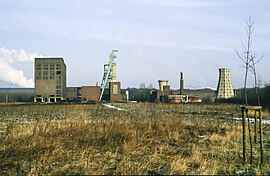Monopoly colliery Grimberg 3/4 shaft
| Monopoly colliery Grimberg 3/4 shaft | |||
|---|---|---|---|
| General information about the mine | |||
| Grimberg Mine 3/4 (1984) | |||
| Information about the mining company | |||
| Funded raw materials | |||
| Degradation of | Hard coal | ||
| Geographical location | |||
| Coordinates | 51 ° 36 '37.7 " N , 7 ° 36' 43.3" E | ||
|
|||
| Location | Weddinghofen | ||
| local community | Bergkamen | ||
| District ( NUTS3 ) | Unna | ||
| country | State of North Rhine-Westphalia | ||
| Country | Germany | ||
| District | Ruhr area | ||
The Grimberg 3/4 colliery was a hard coal mine in Bergkamen in the northern Ruhr area . She was one like the 4 km to the north pit Grimberg 1/2 to mine monopoly , then Haus Aden colliery (2010: Mine East with a mining fields of 285 square kilometers). The system was located in Bergkamen-Weddinghofen on Schulstrasse . Germany's worst mining disaster occurred at this mine in 1946 .
Mining history
The July 1923 to November 1926 , drilled shaft 3 peaked at 411 m depth the carbon. Decommissioned in 1927, he drank in 1930. After the swamps from 1932 to 1934, it was put back into operation in 1936, backfilled to a depth of 800 m in 1946 after the severe mine accident, reopened in 1951, renamed House Aden 3 in 1972 and driven further to a depth of 1635 m in 1987. In 1994 the shaft was filled .
Shaft 4 next to it was sunk from April 1934 to April 1936. It was put into operation in 1936, closed with a concrete cover after the serious mine accident in 1946, reopened in 1948, renamed House Aden 4 in 1972 , and finally backfilled in 1995.
On September 11, 1944, 107 miners , including many Soviet slave laborers , were killed in a firedamp explosion .
On February 20, 1946, 405 miners, including the operations manager and three British officers from North German Coal Control , were killed in an explosion at a depth of 930 m in the so-called Kuckuck shaft . Due to the pressure wave , there were even victims over days and the conveyor systems of shaft 3 were completely destroyed. Only 64 miners survived, who were recovered from the Kiwitt shaft (Grillo 3). It is not clear whether the cause was a firedamp or coal dust explosion , but the investigation report criticized the coal dust : "From the face to the crosscut you walked like a carpet." The last survivor of the accident was Friedrich Hägerling (b . 1922, d. 2013). He was rescued 30 hours after the accident and then had to answer to the British military administration. She accused him of shirking work and only therefore survived. Only after his detailed testimony was Hägerling acquitted. Even today there are occasional commemorations at the Bergkamen forest cemetery . There is a memorial in the cemetery on the southern slope .
In 1948 the mine was reopened. In 1996, both shafts were demolished, and in 2003 the daytime facilities as well .
literature
- Wilhelm and Gertrude Hermann: The old collieries on the Ruhr (series The Blue Books ). Karl Robert Langewiesche, Königstein im Taunus, 3rd completely revised and expanded edition. 1990, ISBN 3-7845-6992-7 , pp. 138-139.
Individual evidence
- ↑ I'm the only one who's still alive : n-tv.de. October 13, 2010
- ↑ Last survivor of the cuckoo accident on: wa.de. September 7, 2011
Web links
- Ingo Bornemann and Angela Tugulu: Grimberg 3/4
- Germany's worst mining disaster: I am the only one who is still alive
- 70 years after the Bergkamen mine disaster , article in FAZ , February 19, 2016 by Reiner Burger



